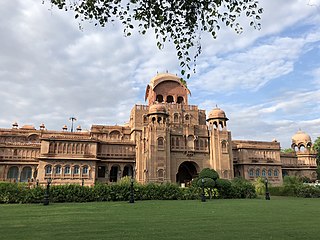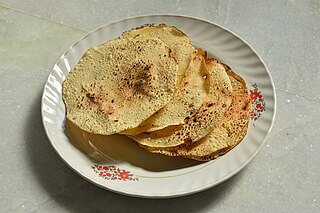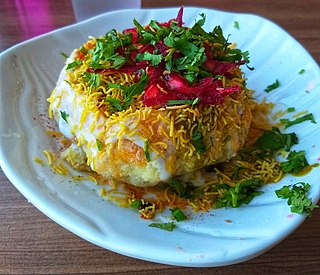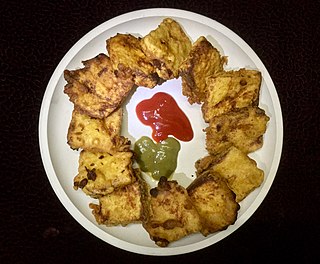Indian cuisine consists of a variety of regional and traditional cuisines native to the Indian subcontinent. Given the diversity in soil, climate, culture, ethnic groups, and occupations, these cuisines vary substantially and use locally available spices, herbs, vegetables, and fruits.

Punjabi cuisine is a culinary style originating in the Punjab, a region in the northern part of South Asia, which is now divided in an Indian part to the east and a Pakistani part to the west. This cuisine has a rich tradition of many distinct and local ways of cooking.

Bikaner is a city in the northwest of the state of Rajasthan, India. It is located 330 kilometres (205 mi) northwest of the state capital, Jaipur. Bikaner city is the administrative headquarters of Bikaner District and Bikaner division.

Pakora is a fritter originating from the Indian subcontinent. They are sold by street vendors and served in restaurants in South Asia. It consists of ingredients, often vegetables such as potatoes and onions, coated in seasoned gram flour batter and deep fried.

Bombay mix or chanachur is an Indian snack mix which consists of a variable mixture of spicy dried ingredients, such as sev, fried lentils, peanuts, chickpeas, chickpea flour ganthiya, corn, vegetable oil, puffed rice, fried onion and curry leaves. This is all flavored with salt and a blend of spices that may include coriander and mustard seeds.

A papadam, also known as papad, is a snack that originated in the Indian subcontinent. Dough of black gram bean flour is either deep fried or cooked with dry heat until crunchy. Other flours made from lentils, chickpeas, rice, tapioca, millet or potato are also used. Papadam is typically served as an accompaniment to a meal in India, Pakistan, Bangladesh, Nepal, Sri Lanka and the Caribbean or as an appetizer, often with a dip such as chutneys, or toppings such as chopped onions and chili peppers, or it may be used as an ingredient in curries.

Rajasthani cuisine is the cuisine of the Rajasthan state in North West India. It was influenced by various factors like the warlike lifestyles of its inhabitants, the availability of ingredients in an arid region and by Hindu temple traditions of sampradayas like Pushtimarg and Ramanandi. Food that could last for several days and could be eaten without heating was preferred. Scarcity of water and fresh green vegetables have all had their effect on the cooking. Signature Rajasthani dishes include Dal Baati Churma, Panchratna Dal, Papad ro Saag, Ker Sangri, Gatte ro Saag. It is also known for its snacks like Bikaneri bhujia, Mirchi bada and Kanda kachauri. Other famous dishes include Dal Baati, malaidar special lassi (lassi) and Lashun ki chutney, Mawa lassi from Jodhpur, Alwar ka mawa, Malpauas from Pushkar and rasgulla from Bikaner, "paniya"and "gheriya" from Mewar. Originating for the Marwar region of the state is the concept Marwari Bhojnalaya, or vegetarian restaurants, today found in many parts of India, which offer vegetarian food of the Marwari people. The history also has its effect on the diet as the Rajputs preferred majorly a non-vegetarian diet while the Brahmins, Jains, Bishnois and others preferred a vegetarian diet. So, the state has a myriad of both types of delicacies.

Chakli is a savoury snack from India. It is a spiral-shaped snack with a spiked surface.
Maharashtrian or Marathicuisine is the cuisine of the Marathi people from the Indian state of Maharashtra. It has distinctive attributes, while sharing much with other Indian cuisines. Traditionally, Maharashtrians have considered their food to be more austere than others.

Kachori is a deep-fried, spicy, stuffed pastry originating from the Marwar region of Rajasthan, India. It is made of maida filled with a stuffing of baked mixture of moong dal or onions, besan, coriander, red chili powder, salt, and other Indian spices and deep-fried in vegetable oil until crispy golden brown. It is served hot with sweet and spicy tamarind chutney or occasionally with mint and green chilli chutney.

Haldiram's is an Indian multinational sweets, snacks and restaurant company headquartered in Noida. The company has manufacturing plants in a wide variety of locations such as Nagpur, New Delhi, Gurgaon, Hooghly, Rudrapur and Noida. Haldiram's has its own retail chain stores and a range of restaurants in Pune, Nagpur, Raipur, Kolkata, Noida and Delhi.

Mirchi Bada or Mirchi Vada is a vegetarian fast food dish native to Jodhpur in the Indian state of Rajasthan. The dish is made by stuffing a green chili with indian spices, mashed potato, and gram flour, then it is wrapped in besan batter and fried until golden brown. It is served hot with tomato sauce or occasionally with mint and tamarind chutney. Banana pepper and Bhavnagri chillis are used for making mirchi bada.

Laapsi or lapsi is an Indian sweet dish made using grain flour or broken wheat and ghee, along with milk, nuts, raisins and other dried fruits. Lapsi is commonly prepared during Hindu ceremonies and is served as a religious offering to Devtas. Lapsi forms an integral part of North Indian cuisine and has many variants.
Bikaner is a city in the state of Rajasthan, India.
Bikanervala is an Indian multinational snack food company and restaurant chain headquartered in Delhi that specializes in Indian sweets and snacks. The restaurant chain has 150 locations both in India and globally.

In Indian cuisine, dal, paruppu, or pappu are dried, split pulses that do not require soaking before cooking. India is the largest producer of pulses in the world. The term is also used for various soups prepared from these pulses. These pulses are among the most important staple foods in South Asian countries, and form an important part of the cuisines of the Indian subcontinent.

Vada, vadai, wada, or bara is a category of savoury fried snacks native to India. Vadas can be described variously as fritters, cutlets, or dumplings. Vadas are sometimes stuffed with vegetables and traditionally served with chutneys and sambar.

Gram flour or besan is a pulse flour made from chana dal or chickpea flour or brown/kaala chana, a chickpea. It is a staple ingredient in the cuisines of the Indian subcontinent, including Indian, Bangladeshi, Burmese, Nepali, Pakistani, Sri Lankan and Caribbean cuisines.

Bread pakora is an Indian fried snack. It is also known as bread bhaji. A common street food, it is made from bread slices, gram flour, and spices among other ingredients.



















